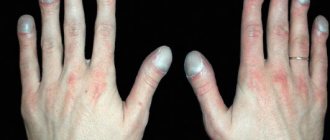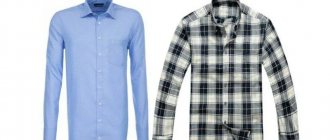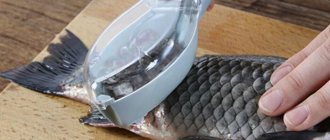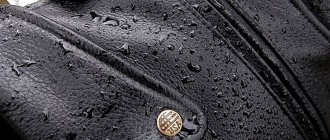What can you make from old warm tights?
This is exactly what we will talk about in our article - what to make from old tights and how to use them.
- Amazing soft dachshund...
- Pads for scenting rooms...
- Decorating glass vases...
- Storing vegetables...
- Bright hair ties...
- An original rug for the home...
- Unique photographs...
- Unusual flowers
Interesting materials:
Why was Mikhail Romanov elected as the new Tsar? Why should you eat red meat? Why is the October Revolution great? Why is the father responsible for raising the boy? Why is Easter celebrated on different dates? Why is the play at the bottom called that? Why is the Cheops pyramid the seventh wonder of the world? Why are eggs poorly peeled? Why is the Celestial Empire China? Why do sunflowers grow in one direction?
Using nail polish to save tights
Puffs and creases on tights can significantly ruin your appearance and mood. In the case where it is not possible to put on a new pair, but there is nail polish, you can stop the further spread of the arrow on the product and prevent the hole from enlarging on the surface of the tights.
- If you notice that an arrow has formed on the surface, you must immediately take a transparent or any other inconspicuous varnish.
- Dipping the brush into the bottle and shaking off the excess varnish, you need to carefully apply a layer to the place where the arrow ends.
- A minute after drying, the crease on the tights will not increase, since its borders are securely fastened with varnish, which has formed a crust that holds the threads of the product.
When you don’t have colorless nail polish on hand, you can use colored nail polish, but in this case it is, of course, better to wear tights under trousers so that the colored dots from the nail polish are not visible.
The method works great even if you decide to wash the product. The crease is reliably contained even after repeated washing of the tights, and the varnish crust does not fall off.
Removing pills from fabrics
Another defect accompanying puffs that forms on the surface of the dress is lint intertwined into a small ball. Knitted and synthetic fabrics are prone to this phenomenon. The pellets do not affect the strength of the material, but they spoil the beauty of the clothing: it gives the impression that the dress has been worn for a long time.
To remove formations from lint, small brushes with a sticky roller inside are made, which are sold in a sewing supply store. The mechanism is simple to use:
lay out the dress on the table;
run the machine from the top of the clothing to the bottom and back;
repeat the procedure until all the pellets disappear.
To remove strands of lint from large knitted items, this method is not needed: the strands are simply cut off with nail scissors. Another source of pellets is pet hair. A mechanical brush will also cope with them, but periodically the mechanism must be cleaned of the fibers accumulated inside. Regular washing will not get rid of puffs and pills.
girls, tell me! The composition of the item is 65% viscose and 35% nylon. I just bought it, hung it in the closet and secured it with a lock from a neighboring dress :((((
and how to remove strings from a silk blouse? Tell me please!!
Smother all the cats.
Try using a needle with a large eye. Stick it from the outside with the sharp end into the base of the puff (try right in the place where the puff came out, thread in thread)
Then carefully continue inserting the needle until the eye of the needle reaches the material and is level with the tightening. Carefully thread the puff into the eye of the needle and pull the needle out from the inside out
The needle will turn the puff to the wrong side. Take the tail of the tie out of the needle and very lightly tug the material around the tie in different directions; if the thread has been pulled out too much, this will straighten it out a little.
Thanks a lot. The Solomon T-shirt was damaged by the Velcro from the bag, the first time I put it on - 20 puffs on my stomach (that’s how I found out that this delicate fabric is similar in structure to double tights :-)). I fiddled with it for 15 minutes and the T-shirt was back in use. Thanks for the method!
Please help! I have graduation in 3 days, and I put strings on my polyester dress! Tell me, how can I remove the marks from the strings?
And my cat, sliding out of the closet along the curtains, made a puff that stretched horizontally along the entire length. How to remove it? Stretching in different directions did not help. Pulling the tip to the wrong side hardly improved the situation; the tightening remained. What to do?
Help me how to remove a puff from a Siobhan dress
How to remove snags on satin and silk When there is only one snag and the fabric around is not frayed, the situation can be corrected. You will need a thin needle. Use it to carefully pull the loop to the wrong side. Afterwards, the material is pulled several times in different directions so that the thread falls into place. Finally, the satin or silk is steamed with an iron. If a path appears under the tightening or there are several similar damages, you will have to seek help from professionals.
How to remove a snag on knitwear If the problem on a knitwear product is limited to just a snag, then the method described above with a thin needle will help save the situation. If the thread breaks and the loops begin to fall down, the defect is eliminated using a special knitted hook. The track is darned from the bottom up, and the last loop is secured from the wrong side. Finally, the knitwear is ironed and steamed. This is required to hide the renovated area.
How to remove a puff on wool Woolen knitted items are repaired in exactly the same way. If we are talking about clothes made from bouclé threads or products made with embossed knitting, then puffs and tracks from dropped loops can easily be eliminated even with a regular crochet hook. When there is no hook at hand, use a large needle.
What to do with claw holes Cute pets are not well versed in brands and valuable things. They leave clues wherever their “velvet” paws can reach: curtains, down jackets, outerwear, etc. How to be in this case? Advice Do not try to test the strength of a thing by stretching it in different directions, as when removing small puffs. Carefully remove the curtain from the curtain rod, and the clothes from the hanger, wrap them with the damaged part inward, so as not to further injure them. Take them to a repair shop.
How to remove snags on different types of fabric
On knitwear
To save a knitwear item, especially a handmade one, from snags, you will need a special elm hook with a hook (the tongue closes the hook, forming a loop) or a thin crochet hook with a clear notch and a sharp tip. In addition, you need to prepare a thin needle with a thread that matches the color of the product.
You can thread the loop in the following way:
- Raise the loop with your hook.
- If a track appears at the tightening point, it needs to be straightened.
- Straighten the loop to the wrong side and tighten, securing with a needle and thread.
After carefully smoothing the product, check if the thread is noticeable. If necessary, treat the canvas with steam.
On synthetics
Artificial fabric is easier to remove puffs. In this case, the method of stretching the material in different directions will be relevant. If the loose thread is too large and does not fit, it can be hidden with a needle. Synthetics are susceptible to mechanical action and easily restore the structure.
Hooks on dresses made of different materials
The properties of fabric for sewing dresses are different, and this must be taken into account when removing puffs on them. The method for quickly repairing defects is universal and can be used for all fabrics, but there are fabrics for which special actions are not required at all. Features of removing puffs on a dress, taking into account the properties of the material:
- Chiffon is a beautiful, but not practical fabric. The threads are removed from the front surface using a needle.
- Wool - removal of strands protruding from the fabric is done with a crochet hook or knitting needle. Defects occur even from long wear, but they are easier to deal with than with puffs on thin materials.
- Silk is a fabric with thin threads. You can’t do without a needle and subsequent steaming of the hook. Carefulness when removing the puff should come first.
- Satin is a fabric made of silk with a special weave, which makes the surface of the fabric smooth. The same recommendations apply to eliminating puffs on such fabric as for dresses made from thin materials.
- Knitwear - if the track from the hook is small, it can be eliminated using the same universal method using a needle or hook. If desired, you can buy a knitting needle for lifting loops with a lock at the end: a locking device prevents the thread from being released from the grip.
- Linen is highly breathable. To make a dress made of this material wrinkle less, it is starched. The puffs from the fabric are removed with a sewing needle.
- Synthetics - made from durable natural or artificial fibers. To get rid of small snags, you just need to tug the fabric, the defect will disappear. Before ironing, you need to look at the label to see if this procedure is allowed for the dress.
- Polyester and elastane are also synthetic materials that look like wool, but have the properties of cotton and are made from durable polyester fibers. Tights on such fabric are eliminated, just like on synthetics - you need to pull the fabric in different directions.
Knitted dresses - in this case, first the loop is pulled inside out of the garment in a universal way. Select a thread to match the defective one, tie and tighten the broken loop.
Expert opinion
Irina. Housewife.
Ask a Question
When multiple puffs are caused by a cat’s claws, you won’t be able to eliminate the flaws on your own. You need to wash the item and take it to a studio where there is special equipment for repairing fabrics.
New solution - office glue
It often happens that creases in tights occur in the office, in an institution where there are practically no means at hand that could save the situation. In this case, we recommend turning to available tools that are available in almost every organization. The most common of them is office glue. It will not only help to cope with the problem of the spread of arrows along the entire length of the stocking, but will also work effectively throughout the entire working day.
- So, we need PVA glue or any other office glue.
- Even a glue stick is suitable for use, so you can safely trust any company that produces these products.
- It is worth treating the entire area around the hole, also touching the edges. It’s convenient that this procedure can be done even without removing the product, that is, on the leg. The glue dries quickly, so that the threads of the product will be protected from further tearing within a short time.
- It is not recommended to delay such mini-repair of the product, since with each movement the hole noticeably spreads.
It is convenient to always carry a small tube of glue in your purse; this will help prevent damage to your tights even in the most unexpected situations.
How to prevent arrows from appearing in advance?
Of course, it is always better to insure yourself in advance than to hastily look for ways to solve the problem later. The ideal option for women who prefer nylon tights or stockings is to carry a spare pair in their purse.
Indeed, you never know whether a pair of tights worn in the morning will last you until the evening or not. But if you are not a fan of playing it safe and carrying a lot of things with you that may be useful in a given situation, use proven tips to help make your tights stronger in advance.
Threads to help you
The ideal solution when the arrow has moved is, first of all, thread and a needle. Sew up the crease with thread - this is the most effective way to save tights. It is better to choose a thread for these purposes that is thin, but at the same time durable, it can be cotton, or it can be with the addition of synthetics. You need to choose a thin needle so that it does not make unnecessary large holes when sewing.
- When sewing up stockings, it is important to be patient and not miss any areas where the threads have broken.
- It is necessary to connect the edges of the arrow with small stitches and move from the beginning to its highest point.
- If along the main length of the product you can sew up stitches in one layer, then on the heel and toe you should sew more tightly, passing more often over one area. This will help avoid re-tearing in places where the tights are stretched - on the foot and on the toes.
- If the tights are torn due to tightening, then you should pay special attention to what contributed to the deformation of the fiber - this could be the zipper of boots, the edges of certain shoes.
- If you often need to wear tights at work, then it would be a good idea to put a small set in your purse - with a needle and thread. It’s enough to choose the most common thread colors and you don’t have to worry about snags and arrows.
Hairspray will quickly save the situation
If an annoying nuisance has occurred, your tights have torn at the most inopportune moment, we recommend turning to the means at hand in order to fix the problem as quickly as possible and prevent the formation of a long arrow and an unsightly hole.
One of the helpers in this case may be hairspray. Thanks to its composition and the film formed on the surface, it will not only hold the fibers of the hosiery together, but will also prevent further unraveling of the material.
The convenience of this method lies in the fact that the varnish can be used in almost any conditions. If trouble happens at work, then just go into the restroom and spray transparent hairspray at a distance of 25–30 cm from the arrow.
It is not recommended to use this method if the polish is colored; in this case, tights can only be worn under trousers.
Even if you buy the highest quality tights, you cannot be immune from holes appearing in them. In this case, special attention should be paid to available means that will solve the problem and not cause much trouble. Moreover, these funds can be found both at home and at work. The main thing is to notice the arrow in time and avoid its spreading.
What colors goes with blue in clothes?
What to wear with a monki puffer jacket
Kinds
How to remove a puff on tights? Here you need to know what type of product you are dealing with. There are several types of tights:
- Thermal tights. They are made from several types of fibers (a mixture of synthetics, wool, elastin, cashmere, etc.).
- Therapeutic (a special type of tights with antiseptic impregnation, intended for women with varicose veins).
- Openwork, decorative (with a pattern, mesh).
- Knitted (similar to knitted, made from wool, half-woolen, cotton threads).
- Elastic (nylon).
It is not possible to remove the puff from all types of tights. The easiest way to do this is on knitted, warm, therapeutic, decorative, and openwork models. The most difficult thing to deal with are elastic transparent tights. The lower the density, the more difficult the task.
If your tights are from 5 to 40 den, you will have to abandon the idea, or resort to radical measures (read below), since, alas, it will not be possible to completely restore the fabric. But the 50 den models still have a chance to “live” for some time.
You can also “conjure” tights with weaves (with mesh, openwork knitting). This is the so-called fantasy option. If you try a little, it can be restored. Let's consider the available methods.
What to do with claw holes
Cute pets are not good at understanding brands and valuable things. They leave clues wherever their “velvet” paws can reach: curtains, down jackets, outerwear, etc. How to be in this case?
It is best to wash the item by hand or by machine on a delicate cycle, and then take it to the studio. There, professionals will remove the claw marks of your pets. It will not be possible to correct the situation on your own so that the puffs are invisible.
- Panic, pulling the thing in different directions.
- Stretch the material, especially knitwear. Pull synthetic fabrics too hard.
- Trim the threads with standard scissors, especially on the front side.
- Try to get rid of the defect by washing at high speeds.
- You should not wash things too often, choose an intensive washing mode, high water temperature or spin at maximum speed. This leads to wear of the fibers and accelerates the formation of puffs.
- It is better to wash delicate items (tights, underwear, chiffon or silk dresses) in a special bag that will prevent the formation of puffs.
- Try to wash clothes on a delicate cycle, without wringing too hard.
- Fabric softeners will help extend the life of clothes and protect the fibers from wear.
We suggest you familiarize yourself with Where and how to store pumpkin at home in an apartment in winter? How to properly store cut pumpkin in the refrigerator?
If a tightening appears, but it is impossible to eliminate it, embroidery or applique at the site of the defect will help.
https://youtube.com/watch?v=ho7Y2XhvW5s
Procedure
When everything you need is ready, you can begin repairing the product:
- turn the nylon tights inside out and stretch the desired area evenly;
- thread the needle and tie a small knot at the end;
- Picking up each loop, make small, neat horizontal stitches to sew up the hole. It is important to use all the loops from the bottom up, forming a neat vertical seam;
- Secure the last stitch with a knot and turn the product right side out.
It will not be possible to sew up the seam completely unnoticed; a thin strip will still be noticeable; the less denier there is in the nylon, the brighter the finished seam will be.











